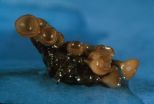(Press-News.org) Use of pine bark extract, at a dose of 200 milligrams per day, appears safe but did not improve risk factors for heart disease, according to a report in the September 27 issue of Archives of Internal Medicine, one of the JAMA/Archives journals.
"Although traditional strategies such as prescription medications, dietary changes and physical activity have proven benefits for reducing cardiovascular disease risk, a substantial population seeks alternative therapies, including various dietary supplements, to lower cardiovascular disease risk," the authors write as background information in the article. Evidence supports the use of some supplements, including fish oil, for treating and preventing cardiovascular disease. However, evidence regarding safety and efficacy is lacking for other supplements marketed to reduce heart risks, including those containing flavonoids prevalent in extracts of pomegranate, grape seeds and pine bark. According to the authors, "pine bark may have possible cardiovascular benefits, especially for blood pressure."
Rebecca L. Drieling, M.P.H., M.M.Q., of Stanford University School of Medicine, Stanford, Calif., and colleagues conducted a randomized, placebo-controlled, double-blind clinical trial of pine bark extract supplements. A total of 130 individuals at increased risk for cardiovascular disease were randomly assigned to take either 200 milligrams of pine bark extract or a placebo once per day for 12 weeks. Participants were asked not to lose weight, change their diet or begin taking any other medications or supplements during the study. Blood pressure and other risk factors were assessed at the beginning of the study and at six and 12 weeks.
Baseline risk factors for heart disease were the same in the pine bark and placebo groups. Over the course of the study, blood pressure decreased by 1 millimeter of mercury in patients taking pine bark and 1.9 millimeters of mercury in patients taking placebo. Other risk factors—including body mass index, blood cholesterol levels, liver enzyme test results, size of cholesterol particles and levels of insulin, lipoprotein(a), fasting blood glucose and the inflammatory marker C-reactive protein—also did not differ significantly between the two groups.
The researchers assessed blood pressure levels among subgroups of participants with higher risk for cardiovascular disease, and still found no differences between those who took pine bark and those who took placebo.
Although it is biologically plausible that pine bark extract could reduce blood pressure through its ability to relax blood vessels constricted by stress hormones epinephrine and norepinephrine, the extract tested in this study was safe but did not improve blood pressure or other heart disease risk factors, the authors note. "Although a different dosage or formulation might produce different results, our findings argue against recommending this pine bark extract to improve cardiovascular disease risk factors," they conclude.
###
(Arch Intern Med. 2010;170[17]:1541-1547. Available pre-embargo to the media at www.jamamedia.org.)
Editor's Note: This research was supported by a research grant from Toyo Shinyaku Co, Ltd, Saga, Japan. Toyo Shinyaku Co, Ltd provided study tablets (Toyo-FVG pine bark extract and placebo). Please see the article for additional information, including other authors, author contributions and affiliations, financial disclosures, funding and support, etc.
END
ANN ARBOR, Mich.---The more complex a plant or animal, the more difficulty it should have adapting to changes in the environment. That's been a maxim of evolutionary theory since biologist Ronald Fisher put forth the idea in 1930.
But if that tenet is true, how do you explain all the well-adapted, complex organisms---from orchids to bower birds to humans---in this world?
This "cost of complexity" conundrum puzzles biologists and offers ammunition to proponents of intelligent design, who hold that such intricacy could arise only through the efforts of a divine designer, ...
Software downloaded during a routine office visit cuts the risk of inappropriate shocks by 50 percent for patients with implantable cardioverter defibrillators (ICD), according to research reported in Circulation: Journal of the American Heart Association.
"Hundreds of patients have been saved from unnecessary shocks by software that is safe and can be painlessly downloaded in one minute during a standard defibrillator check," said Charles D. Swerdlow, M.D., lead author of the study and a cardiac electrophysiologist at the Cedars Sinai Heart Institute in Los Angeles and ...
Using data from more than 270,000 hospital stroke admissions, scientists have identified how to predict which patients are at greatest risk of dying in the hospital after stroke. Before their study, well validated models to predict in-hospital death risk after stroke were lacking, the researchers reported in Circulation: Journal of the American Heart Association.
"A mortality risk assessment tool for hospitalized stroke patients is important to clinicians, hospitals and patients," said Eric E. Smith, M.D., M.P.H., lead author of the study and assistant professor of neurology ...
VIDEO:
In a few tenths of a second, Sclerotinia expels hundreds of thousands of spores in a plume that can rise 20 cm, much higher than any single spore by itself....
Click here for more information.
Long before geese started flying in chevron formation or cyclists learned the value of drafting, fungi discovered an aerodynamic way to reduce drag on their spores so as to spread them as high and as far as possible.
One fungus, the destructive Sclerotinia sclerotiorum, ...
In a paper published this week in the Proceedings of the National Academy of Sciences, Cary Institute aquatic ecologist Dr. Emma Rosi-Marshall and colleagues report that streams throughout the Midwestern Corn Belt are receiving insecticidal proteins that originate from adjacent genetically modified crops. The protein enters streams through runoff and when corn leaves, stalks, and plant parts are washed into stream channels.
Genetically-modified plants are a mainstay of large-scale agriculture in the American Midwest, where corn is a dominant crop. In 2009, more than ...
Burness Communications
Godwin Atser
g.atser@cgiar.org
234-803-443-0027
CGIAR
Scientists arrive in Senegal to give African hunger a black eye
At the World Cowpea Research Conference, crop experts embrace one of agriculture's oldest legumes -- prized for protein and resilience to hot, dry climates -- as food for people, livestock and astronauts
This release is available in French.
DAKAR, SENEGAL (27 September 2010)—A long neglected crop with the potential to halt hunger for millions in Africa, sustain the livestock revolution underway in developing countries, ...
Researchers in the Midwest are developing microelectronic circuitry to guide the growth of axons in a brain damaged by an exploding bomb, car crash or stroke. The goal is to rewire the brain connectivity and bypass the region damaged by trauma, in order to restore normal behavior and movement.
Pedram Mohseni, a professor of electrical engineering and computer science at Case Western Reserve University, and Randolph J. Nudo, a professor of molecular and integrative physiology at Kansas University Medical Center, believe repeated communications between distant neurons in ...
Baby boomers appear to be driving a dramatic rise in suicide rates among middle-aged people, a new study finds.
The suicide rate for middle-aged people – a group considered relatively protected from suicide and with historically stable suicide rates – took an upward jump between 1999 and 2005, according to research by sociologists Ellen Idler of Emory University and Julie Phillips of Rutgers University.
Their study has been published in the September/October issue of the journal Public Health Reports.
"The findings are disturbing, because they're a reversal of a long-standing ...
A report presented today by Health and Consumer Policy Commissioner John Dalli to the Agriculture Council concludes that specific measures relating to storing and the application of isolation distances can help limit or avoid the co-mingling of genetically modified (GM) maize with conventional and organic maize. In particular, the Best Practice Document, prepared by the European Coexistence Bureau (ECoB) and published by the European Commission's Joint Research Centre (JRC), notes that storing seeds adequately and applying spatial isolation are the best ways to limit or ...
TORONTO, Sept. 27, 2010 − Homeless young people are victims of crime at rates that society would consider unacceptable for any other group, according to a new report by researchers at York University and the University of Guelph.
The report, Surviving Crime and Violence: Street Youth and Victimization in Toronto, highlights the degree to which it is street youth themselves − often perceived as delinquent and dangerous − who are vulnerable to crime and violence.
"The very people we are taught to fear are the ones who are most at risk," said Professor ...

